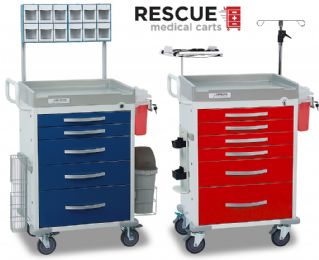








What are Medication Carts?
Medication carts are basically similar in design in that they are typically rectangular or square units with swivel caster wheels and compartments to hold disparate types of medical supplies. Variations can be found in overall weight, size, and color. Depending on a particular model, the number and type of drawers and compartments medication carts offer can also be different. The carts are generally made of polymer, steel, wood, or a combination of all three materials.
The purpose of medication carts is to make it easier for nurses, doctors, and other healthcare professionals to administer an assortment of medications to patients while in the hospital. Because the specific requirements of different hospitals and other facilities vary, medication carts come in an assortment of sizes with different features to suit those customized needs. The type of drawer space differs in certain styles of medication carts as either box carts, bin carts, or punch-card carts.
Most medication carts can be anywhere from 27 to 48 inches long, 40 to 45 inches tall, and generally are about 20 to 25 inches wide. The size differences among medication carts allow for different types and styles of drawers. A box cart is one type of medication cart which has a series of long, narrow drawers divided inside into various sections that hold medications. Another type of medication cart is called a bin cart, and it has rows of smaller, checkerboard type compartments instead of drawers.
A punch-card cart is a type of medication cart which has a series of large, wide drawers in addition to medication bins. The larger drawers are made to hold patient files and paperwork to make it easier for healthcare providers to keep track of the patients’ medications. Many medication carts have a combination of bin, box, and punch-card features. Regardless of the particular style, most carts have compartments that lock, either electronically or with a key. This is where narcotic medications are kept in order to reduce the incidence of theft.
The frame of medication carts is typically made of steel or a steel alloy. To keep the carts from being too heavy, the compartments and drawers are usually made of aluminum, but some units may use a hard polymer. Some facilities want medication carts that are more decorative in nature; therefore, carts with eye-appealing wood finishes can fulfill those style requirements. These particular carts can either be constructed completely of wood or will have steel frames finished with wood laminate.
Specific accessories are often available for medication carts that will broaden their functionality. For example, side accessories may be added to provide an area to keep clipboards, a pull-out writing surface, or poles to hang items from. There are also advanced medication carts available which are called smart carts. These can accommodate a wireless computer, monitor, keyboard, and a scanning device. An onboard computer can allow a caregiver to keep track of the patients and the medications administered electronically. This eliminates the need to carry bulky charts or files, while reducing the chances of paperwork errors.
What is a Crash Cart?
A crash cart is a wheeled chest of drawers or cabinet which contains all of the equipment necessary, from latex gloves to a defibrillator, for emergency resuscitation. Crash carts are positioned conveniently throughout hospitals or other medical facilities so they can be accessed quickly in an emergency. Using the tools on a crash cart require advanced medical skills and certification in ACLS, Advanced Cardiac Life Support. This is a medical protocol that dictates which medical interventions should be used in an emergency situation, and when.
A crash cart is called a code cart in some parts of the world, in reference to the slang term “code” that refers to a patient who is in severe medical distress. Nations that speak British English refer to a crash cart as a code or crash trolley. The lifesaving equipment on a crash cart is extremely important, and for that reason, medical personnel check on its supply levels regularly. This ensures that tools will always be available when they are needed. A separate “code team” is responsible for handling resuscitation and the crash cart in some hospitals.
The drawers of a crash cart are clearly labeled and organized so medical personnel can get what is needed in a hurry. The drawers are normally divided into child and adult sections, because medical supplies and tools come in different sizes for smaller and larger bodies. Drawers are commonly divided into respiratory and cardiac sections, and a separate drawer may be used for the storage of drugs that may be needed during a resuscitation. Most crash carts also have a panel that closes to keep the drawers from sliding open, and to discourage curious people from looking in.
The series of interventions involved in resuscitation can be intimidating and chaotic for those who are not familiar with them, especially since medical personnel do not have time to explain what is going on. Despite the appearance of chaos, the resuscitation team is actually highly organized. Each member knows his or her role and steps in quickly to help as necessary. A well trained crash team operates very smoothly and is capable of making quick medical judgments which may save a life. A crash cart is usually brightly colored to make it easy to identify for medical staff and visitors.
Rehabmart is pleased to carry a comprehensive selection of superior quality medical carts for multiple purposes from innovative and experienced vendors, such as Hausmann Industries, Brewer, Provita USA, IPU, MJM International, Merry Walker, Pivotal Health Solutions, Clinton Industries, Chattanooga, Ideal Products, Luxor Furniture, Mettler Electronics, and others.
Hulet Smith, OT
Rehabmart Co-Founder & CEO
lb